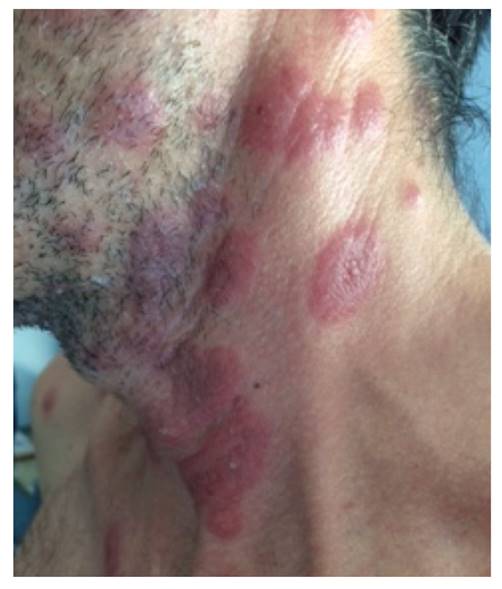Mi SciELO
Servicios Personalizados
Revista
Articulo
Indicadores
-
 Citado por SciELO
Citado por SciELO -
 Accesos
Accesos
Links relacionados
-
 Citado por Google
Citado por Google -
 Similares en
SciELO
Similares en
SciELO -
 Similares en Google
Similares en Google
Compartir
Revista Española de Enfermedades Digestivas
versión impresa ISSN 1130-0108
Rev. esp. enferm. dig. vol.110 no.8 Madrid ago. 2018
https://dx.doi.org/10.17235/reed.2018.5603/2018
LETTERS
Sweet syndrome after treatment with vedolizumab in a patient with Crohn's disease
1Sección Aparato Digestivo. Hospital General Universitario Morales Meseguer. Murcia, Spain
Key words: Crohn's disease; Vedolizumab; Sweet syndrome
Dear Editor,
The adverse pharmacological reactions in the management of inflammatory bowel disease (IBD) complicate the proper use of biological therapies. The effectiveness and safety of vedolizumab described in the article by Olmedo-Martín 1 was read in detail.
In this study, a 42-year-old patient with colon Crohn's disease and a primary failure after two anti-TNF in treatment with azathioprine was admitted due to a severe outbreak with severe endoscopic activity. There was no response to corticosteroids and, therefore, an induction regimen with vedolizumab was initiated. After 24 hours, small pustules began to appear on the back, neck, chest and scalp and a post-infusional adverse reaction was suspected, although the digestive symptoms had improved. The lesions progressed to large violaceous plates, presenting leukocytosis with neutrophilia. The case was assessed by the Dermatology Service, confirming Sweet syndrome associated with Crohn's disease (Fig. 1). A skin biopsy was performed that confirmed the diagnosis. A second dose of vedolizumab was administered without any further incidents.
Discussion
Sweet syndrome or acute febrile neutrophilic dermatosis is an uncommon cutaneous manifestation in IBD 2,3. It is characterized by the appearance of erythematous and painful plaques located predominantly on the arms, upper area of the trunk, neck and face. It is generally associated with a deterioration of the general state, leukocytosis, neutrophilia and fever. In our case, the absence of fever and the appearance of skin lesions after administration of the drug made us initially suspect an adverse reaction to vedolizumab. However, the multidisciplinary management and adequate differential diagnosis of the skin lesions finally allowed treatment with vedolizumab to be maintained and the goal of clinical and endoscopic remission was achieved in our patient.
Bibliografía
1. Olmedo-Martín RV, Amo-Trillo V, González-Grande R, et al. Efficacy and safety of vedolizumab as a treatment option for moderate to severe refractory ulcerative colitis in two patients after liver transplant due to primary sclerosing cholangitis. Rev Esp Enferm Dig 2017;109(9):659-62. DOI: 10.17235/reed.2017.5024/2017 [ Links ]
2. Ortega-Alonso A, López-Navarro N, Gallego E, et al. Crohn's disease and Sweet's syndrome: a debut together. Rev Esp Enferm Dig 2015;107(12):765-6. [ Links ]
3. Catalán-Serra I, Martín-Moraleda L, Navarro-López L, et al. Crohn's disease and Sweet's syndrome: an uncommon association. Rev Esp Enferm Dig 2010;102(5):331-7. DOI: 10.4321/S1130-01082010000500009 [ Links ]











 texto en
texto en 



